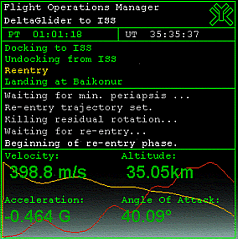

After the de-orbit burn is performed, the re-entry processor takes over. It will wait until the atmosphere is reached and than start to maintain a re-entry trajectory. This trajectory will bring the vessel close to the surface base for landing.
The time graph shows a profile for Altitude (brown) and aerodynamic stress (red). You can see the point of maxQ for re-entry on the left very clearly.
<Step>
<Label>Reentry</Label>
<Processor type="Reentry">
<Var name="Base"> Habana </Var>
<Var name="maxG"> 3 </Var>
<Var name="Vroll"> 5000 </Var>
<Var name="Aend"> 10k </Var>
<Var name="Dend"> 200k </Var>
<Var name="Vend"> 1200 </Var>
</Processor>
</Step>
Base defines the base where we want to land the vessel. When defined, the
Reentry processor will use aerodynamic course corrections to keep the
trajectory close to the landing site.maxG sets the limit for decelleration (currently not used).
Vroll defines the maximum airspeed for roll (bank) maneouvres.
Aend defines an altitude where re-entry is considered complete.
Dend defines a distance to base where re-entry is considered complete.
Vend defines a airspeed where re-entry is considered complete.